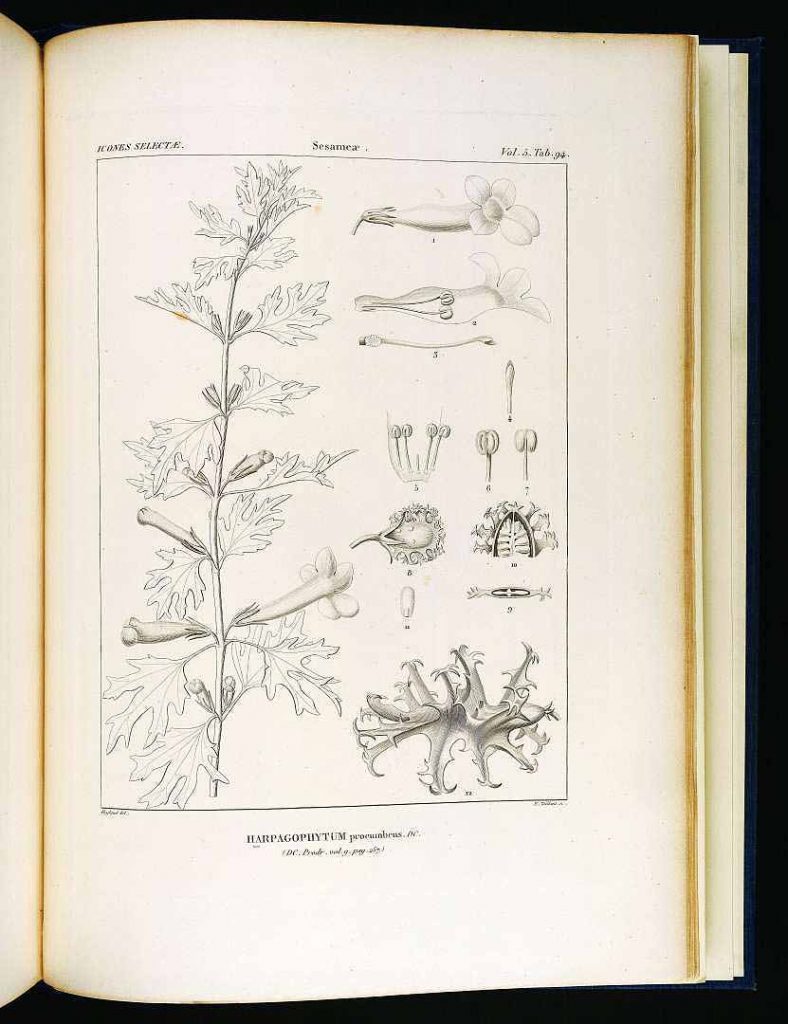African plant devil’s claw may reduce joint inflammation and pain.

Devil’s claw is a plant with a long history of use as a natural pain reliever. Its biochemical properties have given rise to the belief that it may promote joint health by:
- Promoting anti-inflammatory activity. Devil’s claw has been shown to inhibit molecules responsible for inflammation.
- Stimulating analgesic activity. Pain reduction through use of devil’s claw has been demonstrated.
Overview
Indigenous to South Africa, Namibia, and Botswana, devil’s claw (Harpagophytum procumbens) is a shrub-like plant that thrives in deep, sandy soils and regions with low rainfall.
It has been prized in African folk medicine and traditional herbalism for centuries because of its supposed ability to reduce muscle, bone, and skin pain caused by various ailments. Its healing properties were so highly valued in Botswana that the country designated devil’s claw as its national floral emblem.
Beyond pain relief, devil’s claw has demonstrated a remarkable aptitude for anti-inflammation via its primary bioactive ingredient, harpagoside. Devil’s claw has thus been used to manage health conditions associated with inflammation, such as fever, lower back pain, and arthritis.1 2 Clinical research continues to uncover its potential act as a joint health supplement, particularly focusing on its usefulness in treating osteoarthritis.

How Devil’s Claw Might Help With Joint Health
Promoting anti-inflammatory activity
Devil’s claw has displayed potent anti-inflammatory activity, which would otherwise cause pain, swelling, and stiffness in joints. To be specific, its high content of harpagoside blocks the pathway of the transcription factor AP-1, which in turn, prevents the expression of genes in charge of producing inflammatory markers.3 The main inhibited inflammatory cytokines include TNFα, interleukin (IL)-6, IL-1β, and prostaglandin E₂ (PGE₂).4
Harpagoside has also been shown to inhibit the expression of inflammatory cytokines — cyclooxygenase-2 (COX-2) and nitric oxide (NO) — that originate from a different pathway referred to as NF-kappaB.5
Supporting analgesic activity
On top of reducing inflammation, devil’s claw has demonstrated substantial analgesic, or pain-reducing, properties through various yet unidentified mechanisms.6
Devil’s Claw Benefits & Uses for Joint Health

The most common application of devil’s claw has been in the management of joint conditions. It may reduce symptoms of rheumatoid arthritis and osteoarthritis, as well as everyday backache and hip and knee pain.8 A few studies have also reported that it may help manage a complex form of arthritis characterized by sudden, severe bouts of tenderness and pain in the joints known as gout by reducing high levels of uric acid.
In terms of athletic praxis, devil’s claw may potentially be healthy for the joints of athletes participating in anaerobic exercises, including bodybuilding and gymnastics.9
Research
Animal Research
Animal research indicates that devil’s claw may promote joint health by:
- Facilitating cartilage repair in rabbits10 11
- Reducing pain and inflammation in the joints of arthritic rats12
- Minimizing edema in the joints of arthritic mice13
Human Research
Most of the available clinical research suggests that devil’s claw can reduce lower back, knee, and hip pain and inflammation, though many of the studies are poorly designed.
Devil’s claw (2400 mg) may reduce pain and symptoms of osteoarthritis.
In this uncontrolled, open clinical investigation, 75 patients with osteoarthritis of the hip or knee were given 2400 mg of a devil’s claw extract containing 50 mg of harpagoside daily for 12 weeks. Supplementation with devil’s claw led to a strong reduction of pain and the symptoms of osteoarthritis. Overall pain was reduced by 23.8%, stiffness was reduced by 22.2%, and physical function was improved by 23.1%. Continuous improvements were also noted on clinical evaluation, including reduced pain on palpation, minimized joint grating, and improved mobility.
- The researchers concluded that “Devil’s claw extract has a clinically beneficial effect in the treatment of arthrosis of the hip or knee.”14
Devil’s claw (6000 mg) may reduce symptoms of osteoarthritis
In this uncontrolled surveillance study, 227 patients with lower back, knee, or hip pain took a 2000 mg of a devil’s claw extract containing 20 mg of harpagoside known as Doloteffin 3 times a day for 8 weeks. Approximately 50% to 70% of the patients had improvements in pain and function with few adverse side effects. Greater improvement was noticed in patients when the initial pain and disability was worse.
- The researchers concluded that “Doloteffin is well worth considering for osteoarthritic knee and hip pain and nonspecific low back pain.”15
Devil’s claw (6000 mg) may improve subjective ratings of joint conditions
In this uncontrolled surveillance study, 114 patients with lower back, knee, or hip pain were given 6000 mg of Doloteffin containing 60 mg of harpagoside every day for up to 54 weeks. About 75% of patients rated the treatment as “good” or “very good” based on subjective ratings.
- The researchers concluded that patients taking Doloteffin “indicated an appreciable overall improvement during the surveillance.”16
Devil’s claw may reduce pain in osteoarthritis
In this literature review from 1966 to 2006, 14 clinical trials — 8 observational, 2 comparative, 4 double-blinded, placebo-controlled, and randomized — tended to agree that devil’s claw was effective at reducing pain in patients with osteoarthritis. These data, however, were limited by small population sizes, and many of the studies were deemed to be of low methodological quality.
- The researchers concluded that “the data from the higher quality studies suggest that Devil’s Claw appeared effective in the reduction of the main clinical symptom of pain. The assessment of safety is limited by the small populations.”17
Dosage for Joint Health
- Successful clinical research studies use from 2400 – 6000 mg of devil’s claw containing approximately 20 – 60 mg of harpagoside.
- Typical devil’s claw supplements range from 960 – 1400 mg per day.
Available Forms
- Capsules or tablets
- Powder
- Tincture
- Liquid or aqueous extract, often in the form of drops
Supplements in Review Says
- Devil’s claw 750 – 1000 mg containing 20 mg of harpagoside for joint health.
Devil’s claw may reduce pain and inflammation in the joints. Clinical studies support the use of devil’s claw as a pain reliever and anti-inflammatory, but the true effectiveness and safety of the plant in promoting joint health is still being investigated.
Take devil’s claw standardized to at least 20 mg of harpagoside. Clinical studies consistently use aqueous extracts of devil’s claw standardized to at least 20 mg of harpagoside.
Leave a Reply